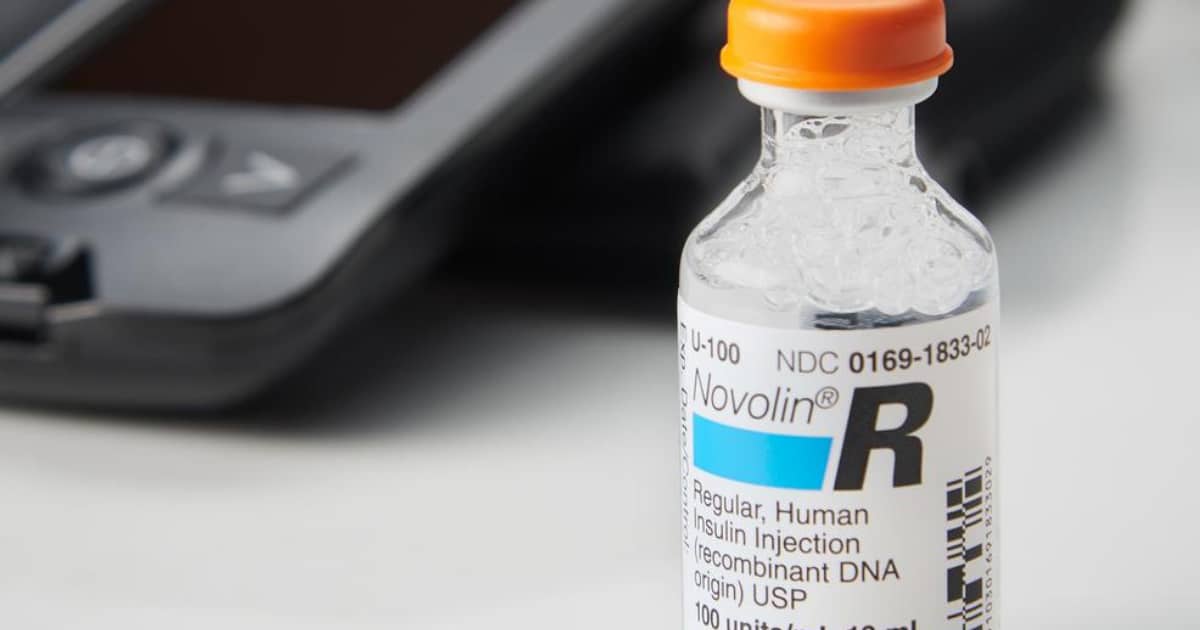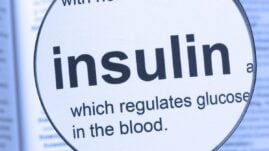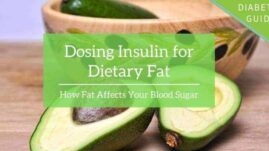The cost of insulin is a serious problem for many people who live with insulin-dependent diabetes in the United States.
That’s why some people turn to Walmart’s ReliOn Insulin and other over-the-counter insulins.
In this article, we’ll discuss what kinds of insulin are available from Walmart’s “ReliOn” brand, what they cost, how they work, and if they are a good option for you.
Update: We have added a list of announcements and new products to the end of this article. Please read the full article before skipping to the end as it’s important to understand the different types of insulin available from Walmart before choosing one.

Walmart’s ReliOn Insulin
The over-the-counter insulin from Walmart that costs about $25 per vial is limited to two types of insulin:
- Regular (insulin R)
- NPH (insulin N)
You can also get a premixed combination of NPH and Regular called 70-30.
Both of these insulins are what’s called “synthetic human insulin”. It’s different from newer insulins that are called insulin analogs.
Both require a very rigid eating schedule. In the “old days” of type 1 diabetes management, a patient taking Regular and NPH insulin would have to eat a very specific number of carbohydrates every 2 to 3 hours.
If you don’t adhere to a consistent eating schedule and carbohydrate quantity, you will experience recurring severe low blood sugars.
For example, as a child with type 1 diabetes in the 90s, I followed a regimen like this:
- 8 a.m.: 45 grams of carbohydrate
- 10:30 a.m.: 15 grams of carbohydrate
- 12 p.m.: 60 grams of carbohydrate
- 3 p.m.:15 grams of carbohydrate
- 6 p.m.: 60 grams of carbohydrate
- 8:30 p.m.: 15 grams of carbohydrate
Your life is ruled by the clock when you’re taking these types of insulin compared to the flexibility and freedom that comes with today’s insulin options.
Patients who switch to these insulins without guidance from a healthcare professional may be unaware that these insulins do not work in the body like the newer insulin they were likely taking before. This can lead to severe blood sugar fluctuations and be potentially fatal.
Let’s take a closer look at Regular and NPH insulin.
Regular insulin
Regular insulin is also referred to as “short-acting” insulin and is taken several times per day.
It used to be the only option for managing your blood sugar around meals, but compared to today’s “rapid” and “fast” acting insulins, Regular insulin is very slow-working because it stays in your system for a long time, up to 8 hours, and peaks nearly 4 hours after injecting it.
If you don’t eat every 2 to 3 hours while taking multiple daily doses of Regular insulin, you will experience multiple low blood sugars.
More modern insulin is active in your bloodstream within 15 minutes and out of your bloodstream within 4 hours. This means you don’t have to worry about dropping low or feeding that insulin dose after 2 to 3 hours of taking it.
In hospitals, patients will find that when receiving insulin via IV, short-acting insulin is still commonly used based on traditional “sliding scale” insulin dosing protocols.
NPH insulin
NPH insulin is also referred to as “intermediate-acting” insulin. It used to be the only “background” insulin option, but much like Regular insulin, it pales in comparison to today’s other background options.
NPH only stays in your system for anywhere from 10 to 16 hours and has to be taken twice per day in order to cover your 24-hour background insulin needs.
It also takes several hours to become active in your bloodstream, and it peaks at approximately 4 to 6 hours after taking it. Today’s long-acting insulin options — Basalgar, Lantus, Levemir, Tresiba, Toujeo — have generally no peak at all.
The peak in NPH contributes to the rigid eating schedule a person must follow if they’re using these older insulins to manage their blood sugars.
Do you need a prescription?
In short, no, you do not need a prescription to buy Walmart’s Regular or NPH insulin. However, you won’t find it sitting on the counter next to the Tylenol either.
You’ll have to go to a Walmart store and ask a pharmacist for a vial in order to purchase it.
While it’s considered an “over-the-counter” medication now, it’s still managed very carefully by the pharmacy because it needs to be refrigerated and it’s still a high-value medication despite being only $25 per vial.
Is Walmark insulin a good option for you?
Considering that today’s most modern insulin options cost at least $300 per vial, the affordability of Walmart’s insulin is appealing. Unfortunately, the rigid schedule and limitations of these insulins truly make them a “last resort” option.
They are especially challenging for younger children who have unpredictable eating habits and an inevitably lesser understanding of how important it is to eat a specific amount of food at a specific time of day.
These insulins will help you stay alive if you truly cannot afford more modern insulin. If they are the only type of insulin you have access to, then yes, it is a good option for you.
If you can get more modern insulin through your health insurance or one of the many financial assistance programs that exist today, you’d be better off going that route.
Sure, it’s nice that these older insulins are easily accessible but they are not the solution for a long, healthy, full life for a person with diabetes. They are the last resort.
Latest updates
July 6, 2021 – Walmart today announced that it will begin selling its own private brand, rapid-acting, analog insulin called ReliOn NovoLog. The new insulin is now available in Walmart pharmacies and is expected to also be available in Sam’s Club stores in mid-July. You need a prescription to purchase this insulin.
It will be available in two different forms: either $73 per vial (10 mL each, or 1,000 units) or $86 for a package of five prefilled insulin pens (FlexPens, each with 3 mL, or 300 units).
Walmart’s private label insulin will be manufactured by Novo Nordisk and is similar to Novo Nordisk’s NovoLog brand.





Howard Hudson
I survived for several years using WalMart Type R and Type N insulin. The savings are significant: No Rx means I save $300 for a doctor’s Rx, $25 per vial and syringes at $10/100 make it very affordable compared to $300 per vial or ten more for pens.
I used those savings to buy the least expensive test strips I could so I could check pre- and post-prandial (meal) glucose levels all the time. Take R 30 minutes before you eat (takes longer to be active) and monitor with your test strips. By measuring frequently, you can learn your body’s response to diet, exercise, and food consumption.
Each diabetics is like an fingerprint, each one is unique. But measuring YOUR body in YOUR life is the best way to maintain good control.
Marie
I have gone to Wal-mart for my relion 70/30 twice now and the pharmacy tells me they try to order it but it’s like it has been discontinued.
Christel Oerum, MS
Thank you for sharing that. I haven’t heard anything about it being discontinued. Could you try contacting another Wal-Mart?
Jim Collns
Two weeks ago, at Walmart I was told my 70/30 is “back ordered”. Just today, gong back, at first they said “back ordered”…then “not making it anymore. Suggested Type N which I bought…same price. (Vial)
Reading up to Type N I see no real difference except it does not have the “short acting” part. Type N is a long lasting product.
70/30, according to some has been discontinued due to lack of orders.
Also, some say it is manufactured in Israel…and now with their war gong on……….
NR STEVE
I’m curious what a person is to do if they are allergic to protamine which is a fish protein, how are they supposed to control blood sugar? In the olden days there was Humulin L, lente insulin zinc suspension that offered great control.
Nph insulin I believe is usually 2/3rd in the morning and 1/3 at night but can vary by person, perhaps may 75/25 or 70/30 (not to confused with the label indicating how much protamine is in the drug). I read that sometimes children may need multiple NPH shots because if you take less insuin at a time it doesn’t become as much variable.
Gabrielle B
I have been through the gamut of insulin use regimens from pumping, to MDI to insulin analogs, to NPH/regular. Right now, I am using OTC NPH and regular. I would rather be on lantus/humalog, and my A1c drops by
1/2-1 points when on the analogs, but I am an older diabetic and I live with the higher A1c (I would not do this to a child…A kid should be on a pump with CGM, in my opinion, with regular and not an analog). So, what I have works instead of the strict regimens most of us older folks were exposed to as child: right now, I am using OTC NPH and regular, and a regimen that simulates MDI pretty well. I give 15 units of regular and 6 units of NPH before meals, and wait until I feel the “edge” and then eat. (Obviously, your mileage may vary here). It ends up being 3-4 injections/day but I don’t usually have lows in the middle of the night.
PS Doff
Walmart’s ReliOn Novolin insulin IS Novo Nordik Novolin insulin. It is simply packaged in a different box even the insert in the package is exactly the same.
If it weren’t for Walmart, Novo Nordisk would have stopped making Novolin in 2010 as they threaten to do in 2008 because of reduced demand.
PS Doff
There is erroneous information in this article about human synthetic insulin. The description of its action peaking at 4 hours and lasting for 12 is for the NPH version,. Regular synthetic insulin has a peak at about 2 hours.
A type 1 diabetic using both regular and NPH insulin is not locked into the schedule that this person remembers from childhood.
An average person without a significant amount of effort can learn to gauge the amount of carbohydrates consumed in a meal and to use what’s called a sliding scale adjustment using glucose self testing which can be done for less than 20 cents per test. This is the same kind of adjustment that’s used with the insulin analogs. The only difference is the delay between when human type insulin is released and when it is used is closer to natural. .
What’s not emphasized in this article is that recumbent DNA human synthetic cancer is insulin is the the same as a healthy body produces. It’s just produced by lab drown modified bacteria instead of beta cells. Analog insulins are also synthetic, but not exactly insulin.
Analogs have some pros and cons. The rapid analogues are good for insulin pump trickle use. They are worse for MDI because they can more quickly induce hypoglycemia and they promote instant gratification and poor meal planning habits, which should not be a dietary practice for any person with diabetes.
The chief disadvantage of analogs is cost. Whethrr used with insulin pumps or MDI they cost three to four times as much as human synthetic insulin.
.There’s a much larger cost to using analogs with insulin pump and CGM compared to human insulin , GSM and MDI, more than 10x as much and always paid for by someone. For mentally and physically capable adultd, that cost diffrce is not justified by outcomes.
Long release analogs for basal use are a different story; they can reduce hypo events for persons with erratic lifestyles.
I’m a senior, had type 1 for more than 40 years and I don’t think that I’m exceptional in that I’m able usually able to maintain my A1C’s well under the (very loose) AACE limit without difficulty and without significant hypo episodes or complications. I’ve used human synthetic insulin for more than half of that time I’ve used analogues for a period of about 5 years and the difference in my control was insignificant.
Belittling something because it is older and favoring something because it is more convenient at much higher cost does not make sense from a medical standpoint.
Extensive clinical trials have been done over the years that in aggregate show the advantage to an individual patient in terms of outcomes from using analog insulin is statistically insignificant. Pharmaceutical companies would like you to not know that. The studies that they promote show small single digit significant statistical results which are touted as breakthroughs and improvements. What they don’t make clear to the average person is the variability of those results or the cost.
Martin
Thank you for a very well written reply. the old insulins are as good as the new ones and much less expensive, and in my experience, the analog insulins require higher doses than the old preparations, The pharmaceutical companies have been doing a massive training program aimed mostly at diabetologists to convince them to recommend the more expensive drugs.
Nol
Thank you for the information. Struggling diabetic without insurance- I haven’t been to the doctor in 9 years. Call me stubborn all you want but a practitioner or doctor that read a chapter about diabetes in med school over 20 years previous DOES NOT always know best.
Mary
You are 100% correct that most PCP’s have very little knowledge regarding T1D (IDDM). The same is true for R.N.’s and it trickles down. Our endocrinologist advised us on day one that we would be given incorrect information on how to manage T1D based on the statistics that 98% of all diabetes are Type 2 leaving just 2% with the “juvenile diabetes/type 1diabetes/IDDM (Insulin Dependent Diabetes Mellitus). If we had a nickel for each time someone gave us unsolicited, incorrect “advice” we would no longer be alive, however, all of those nickels would cover the funeral costs.
John nichols
A couple of brief questions first does insurance cover any of the cost of the new relion brand of Novolog like insulin. Second I know Novalog and Humalog are interchangeable in my pump as far as the way they act because my insurance made me change from novalog to humalog, is the new Walmart brand interchangeable with the two aforementioned insulin’s. Third of it is interchangeable, can it be used in an insulin pump. I’m asking because I use 1000 units a month on average and my 200 dollar co pay adds up.
Christel Oerum
According to Walmart, the price of ReliOn Novolog would be the same as if you used insurance, which is basically another way of saying that they don’t take insurance. If you already have a NovoLog prescription their pharmacist should be able to switch that over to ReliOn for you.
It’s manufactured by Novo Nordisk and should be interchangeable with the branded version. As I read it, this is the first type of “White label” insulin we’re seeing. Quote: “ReliOn NovoLog is the “same product, same quality, same safety, same efficacy,” of other analog insulin”, that also means it should work in your pump but talk to your doctor or the pharmacist to make sure you’re getting the right product as the Regular and NPH shouldn’t be used in a pumo
PS Doff
Novolin is to Humulin
As Novolog is to Humalog, the box that comes in doesn’t make any difference.
In 2022 it’s iffy whether a prescription plan will cover the reliant brand.
Humana is resisting even though none of their plan documents say so. If your prescription plan is has $35/month insulin coverage, you may be better off with one of the other. I’m Medicare the $480 a year initial stage of coverage makes all the difference.
Juilene D. LAMBUS
I started getting Relion Novolog from Walmart, after my Prescription for Lantus was economically unavailable to me do to a Stop Gap or Donut Hole with my insurance. I started on July 1st 202, with my first 44 unit injection, i developed a bump under my skin at the injection sight. I called Walgreen, the pharmacist told me to massage the bump ( i did). Nothing,,,, i called my Doctor, she didnt seem too concern. I continued the injections, went to see my Doctor, she asked do i want to get back on Lantus, how? I am a senior, living on a low income fixed budget. Lantus would cost me $277.00 for 10 pens. I cant afford that. So now i have 20 plus bumps going around my navel. I kept every Relion pen i have used. It was always cloudy, the pharmacist said to shake the pen. Im just putting this on record. I will send pictures and i left insulin in the used pens, in case something serious happens. It never brought my Blood sugar levels down, only 25-40 points. I stop even using them on September 30. I know you wont publish my comment.
Christel Oerum
What a terrible experience. There are other options to Lantus such as Semglee (https://youtu.be/1rz7ruzzIzY) it’s an interchangeable biosimilar to Lantus and should be much more affordable (but still not cheap), but see the video for more information on it. Another option is Basaglar (https://diabetesstrong.com/basaglar-vs-lantus/). I don’t know why your doctor didn’t mention these as your body clearly doesn’t do well on the insulin you describe
Maria T.
I have been using Relion insulin for years now as I can’t afford the co-pays for the insulin my doctor prescribes. I have been a diabetic for over 40 years and this “old insulin” was the only available insulin when I became diabetic. Ask your doctor for a syringe with a longer needle, I can pretty much guarantee that you will no longer have bumps under the skin. If you take a lower dose of insulin it is ok to use a short needle. 44 units is a larger dose, try a syringe with a longer needle so it goes deeper and your bumps will be gone. Also, we were taught to inject at an angle, and just under the skin, try going straight in. The deeper in, you will have no bumps.
Paul
I use these and they work very well. You have to rotate injection sites or you will get a tender spot. The N works better than Lantus for me and there is a large study that indicates there isn’t much difference between these old insulin’s and the new expensive stuff. You have to control your carbs if you have diabetes anyway. The difference may be instead of two shots a day you might have to do three to smooth out the effect.
David
Cloudy, poorly working insulin suggests that the insulin was not stored properly. Insulin by become cloudy if not refrigerated or exposed to high temperatures for long enough. This might mean that at some point in WalMart’s logistics chain, their insulin is not being refrigerated. Obviously, this is a huge problem. If they sold you defective insulin, you should return it and escalate the problem to the corporate level. WalMart sells a lot of low quality products, but if they’re selling low quality insulin, they should get out of the business of selling insulin. Someone needs to grab three vials from that store, send them to a lab for analysis, and figure out what the hell happened.
Sophia
The N insulin should be cloudy. It always appears cloudy in the bottle and the syringe. The cloudiness has nothing to do with refrigeration or being defective. The R insulin should be clear. Expensive or cheap, N is always cloudy.
OG Diabetic
^ 100% correct.
PS Doff
A bump under the skin that appears immediately after an injection has a most likely cause
It’s a combination of the isophane being denser,the dose size and athe injection was not deep enough in the skin. That should disipate. DO NOT massage an insulin injection site. That can cause scarring and long term bumps.
I would split the dose between two sites in different zones like one in
the abdomen and I on an arm or thigh. Rotate sites
Ussing longer needles may help.
If your Lantus regimen was once per day, consider changing to a morning and an evening dose.